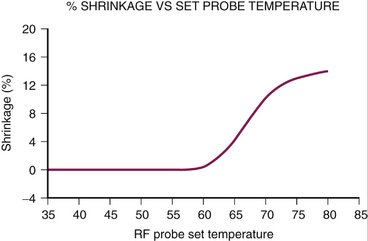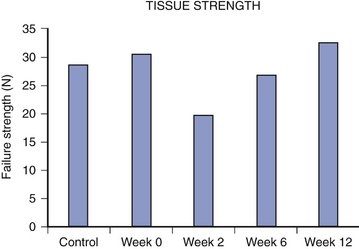W6 Capsular Shrinkage in the Treatment of Wrist Instability
Basic Science
Capsular shrinkage was used by Hippocrates 2400 years ago to stabilize dislocated shoulders. More recently (comparatively speaking), the biology of capsular shrinkage has been extensively studied in animal models. These studies have shown that the triple helix of collagen “unwinds” and “shrinks” when heated to 60°C, maximum shrinkage being achieved between 65°C and 75°C (Figs. W6-1 and W6-2). The hydrogen bonds maintaining the three-dimensional configuration of the type I collagen triple helix rupture as the collagen is heated to greater than 60°C. The denatured collagen can potentially shorten to 50% of the resting length of the untreated collagen. The shortened denatured collagen acts as scaffolding onto which new collagen is deposited.1 The new collagen fibers maintain this shortened conformation, ensuring the long-term maintenance of the shortening.
Biomechanical studies have shown that the tensile strength of heated collagen decreases rapidly and does not return to normal values for 12 weeks.2 The tensile strength returns to nearly 80% normal by 6 weeks after heating (Fig. W6-3). This transient loss of tensile strength would suggest that the application of stress to recently heated collagen is contraindicated. Premature loading of the shrunken collagen would lead to a lengthening of the collagen; this has been verified in an animal model.3,4 Based on these data, it would seem reasonable to recommend at least 6 to 8 weeks of joint immobilization after capsular shrinkage. Heavy loading of the joint should be avoided for 12 weeks.
Technique
General Information
Shrinkage requires very low energy settings. The radiofrequency (RF) devices must be adjusted to heat the tissue to a temperature of 65°C to 75°C. It is wise to start at low energy and slowly increase the energy output until the desired shrinkage is observed. If a laser is used, it should be set to very low energy (i.e., 0.2 to 0.5 J at 15 pulses per second [3 to 7.5 W]). The laser is held away from the target ligament and slowly advanced until the ligament is seen to shrink. When the shrinkage has stopped, continued heating further weakens the ligament only without increasing the shrinkage. The color of the ligament changes from white to light yellow during the shrinkage. Lu and associates5 suggested that a cross-hatching shrinkage pattern optimizes the ingrowth of healthy tissue and hastens the recovery of the ligament. During the shrinkage, the traction on the wrist should be reduced as much as possible to permit optimal shrinkage.
Scapholunate Instability
The question is what should or can be shrunk to stabilize the scapholunate axis? The scapholunate interosseous ligament is a heterogeneous structure. Its central portion is composed of fibrocartilage, which is not shrinkable (Fig. W6-4










